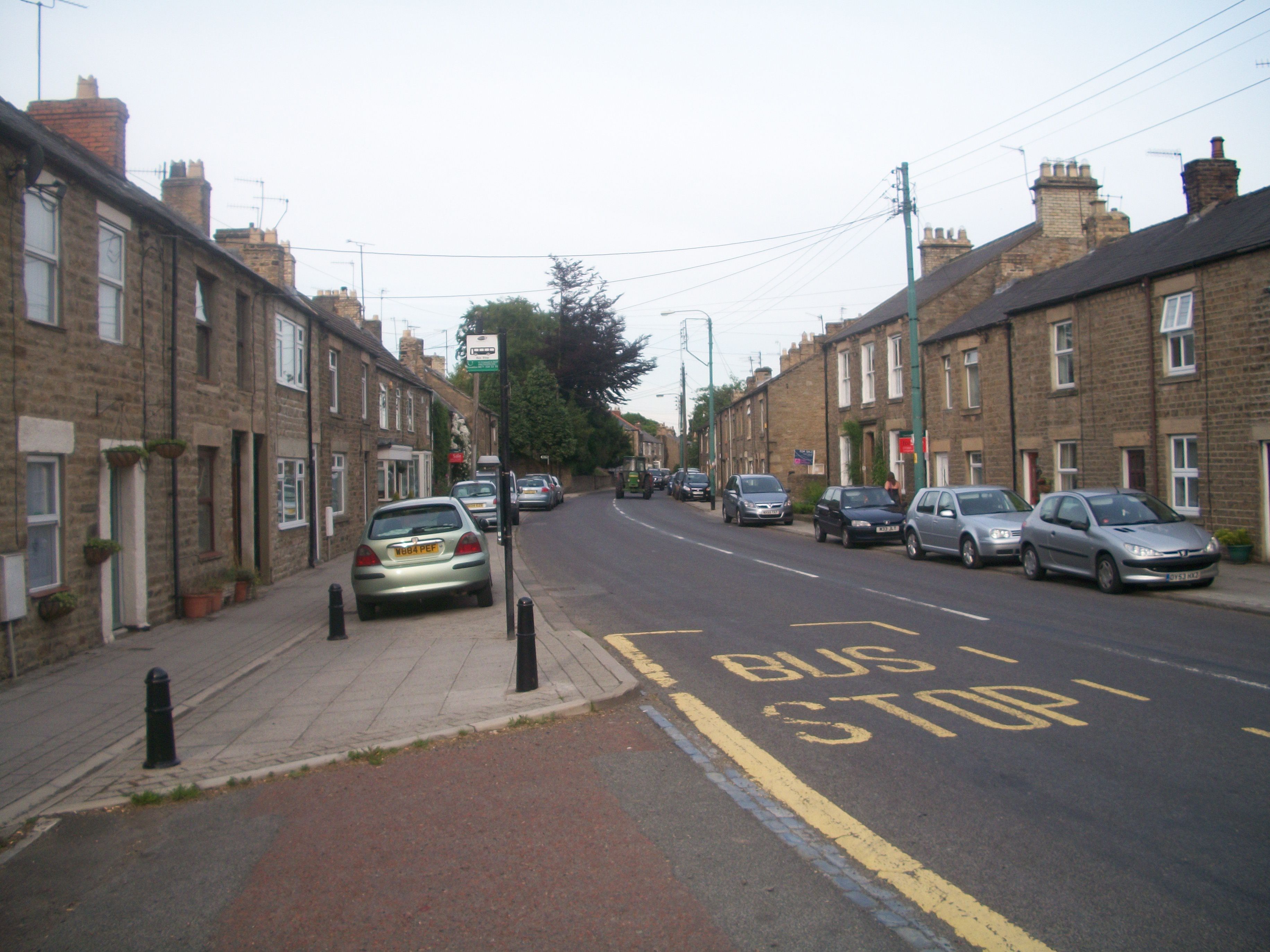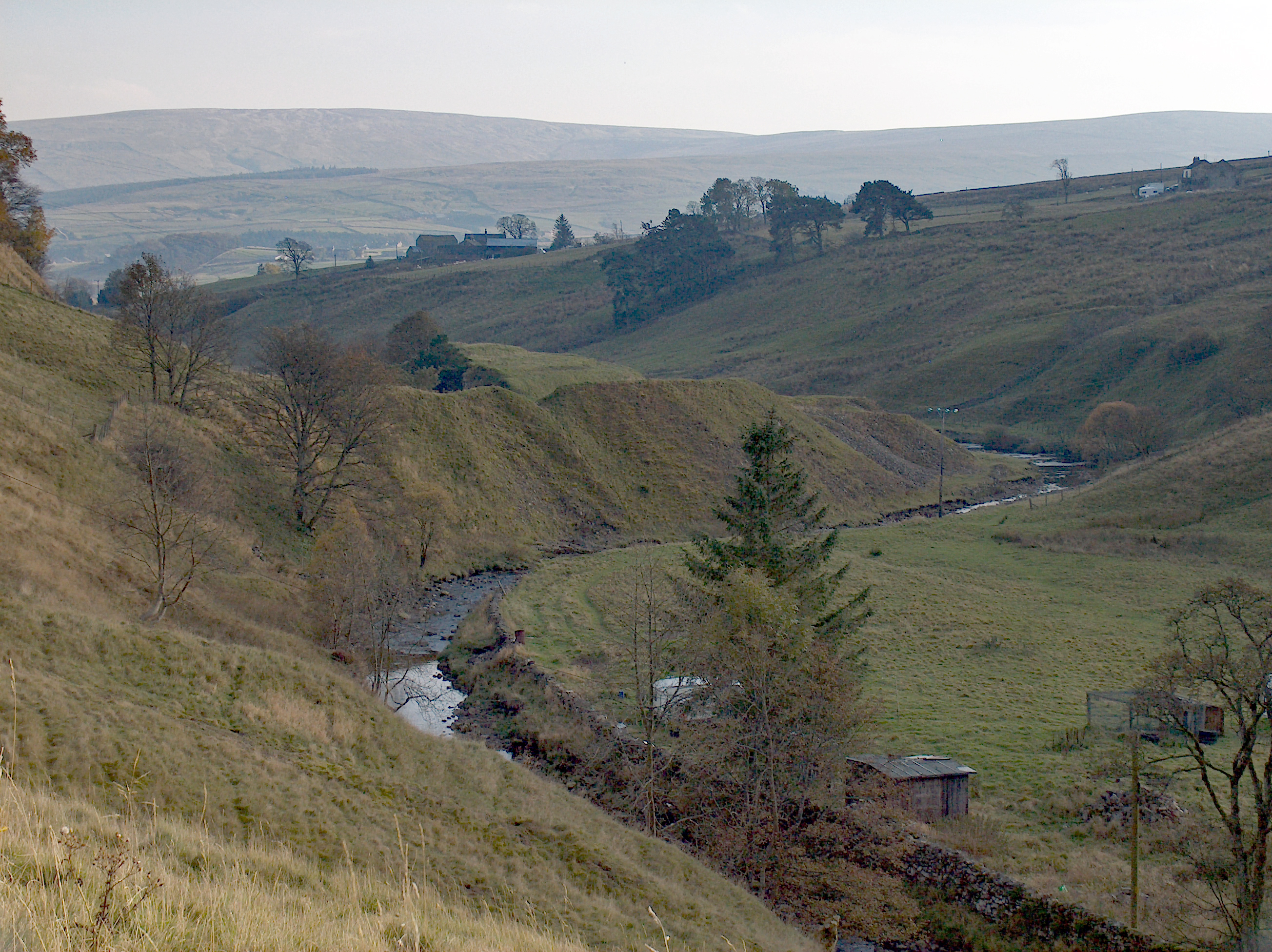|
Frosterley
Frosterley is a village in County Durham, in England. It is situated in Weardale, on the River Wear close to its confluence with Bollihope Burn; between Wolsingham and Stanhope, County Durham, Stanhope; 18 miles west of Durham, England, Durham City and 26 miles southwest of Newcastle-upon-Tyne. In the United Kingdom Census 2001, 2001 census Frosterley had a population of 705. Frosterley is on the Weardale Railway. Heritage trains currently run to Stanhope, County Durham, Stanhope, Wolsingham and Witton-le-Wear History The area has been inhabited since Mesolithic times: Mesolithic flints and Neolithic stones axes have been found in the vicinity. A bronze spearhead was found in a local quarry dating to the late Bronze Age circa 1000 BC. The village itself has Middle Ages, medieval origins, and although the original houses have long been replaced, the village still retains its medieval pattern. On the north of the village are the remains of Saint Botolph, St Botolph’s Chapel. ... [...More Info...] [...Related Items...] OR: [Wikipedia] [Google] [Baidu] |
Frosterley Marble Detail
Frosterley is a village in County Durham, in England. It is situated in Weardale, on the River Wear close to its confluence with Bollihope Burn; between Wolsingham and Stanhope; 18 miles west of Durham City and 26 miles southwest of Newcastle-upon-Tyne. In the 2001 census Frosterley had a population of 705. Frosterley is on the Weardale Railway. Heritage trains currently run to Stanhope, Wolsingham and Witton-le-Wear History The area has been inhabited since Mesolithic times: Mesolithic flints and Neolithic stones axes have been found in the vicinity. A bronze spearhead was found in a local quarry dating to the late Bronze Age circa 1000 BC. The village itself has medieval origins, and although the original houses have long been replaced, the village still retains its medieval pattern. On the north of the village are the remains of St Botolph’s Chapel. What remains is an earthwork mound surrounded by a modern housing estate (Kirk Rise). The site was excavated in 1995, ... [...More Info...] [...Related Items...] OR: [Wikipedia] [Google] [Baidu] |
Frosterley Station And Xmas Special - Geograph
Frosterley is a village in County Durham, in England. It is situated in Weardale, on the River Wear close to its confluence with Bollihope Burn; between Wolsingham and Stanhope; 18 miles west of Durham City and 26 miles southwest of Newcastle-upon-Tyne. In the 2001 census Frosterley had a population of 705. Frosterley is on the Weardale Railway. Heritage trains currently run to Stanhope, Wolsingham and Witton-le-Wear History The area has been inhabited since Mesolithic times: Mesolithic flints and Neolithic stones axes have been found in the vicinity. A bronze spearhead was found in a local quarry dating to the late Bronze Age circa 1000 BC. The village itself has medieval origins, and although the original houses have long been replaced, the village still retains its medieval pattern. On the north of the village are the remains of St Botolph’s Chapel. What remains is an earthwork mound surrounded by a modern housing estate (Kirk Rise). The site was excavated in 1995, ... [...More Info...] [...Related Items...] OR: [Wikipedia] [Google] [Baidu] |
Weardale Railway
The Weardale Railway is an independently-owned British single-track branch line heritage railway between , Witton-le-Wear, Wolsingham, Frosterley and Stanhope. Weardale Railway began services on 23 May 2010, but decided to run special trains rather than a scheduled service for the 2013 season. The line was purchased by the Auckland Project in 2020 with a view to restarting passenger services. In 2021, a bid was submitted to the ' Restoring Your Railways fund. In October 2021, the Department for Transport allocated funding for the development of a business case. The railway originally ran from Bishop Auckland to Wearhead in County Durham, North-East England, a distance of , built in the nineteenth century to carry limestone from Eastgate-in-Weardale, and provide passenger services to Weardale. Passenger services ceased in 1953, leaving only freight services to Eastgate until 1992. After the quarry's owner Lafarge moved to road transport in 1993, the line was threatened with c ... [...More Info...] [...Related Items...] OR: [Wikipedia] [Google] [Baidu] |
Stanhope, County Durham
Stanhope is a market town and civil parish in the County Durham district, in the ceremonial county of Durham, England. It lies on the River Wear between Eastgate and Frosterley, in the north-east of Weardale. The main A689 road over the Pennines is crossed by the B6278 between Barnard Castle and Shotley Bridge. In 2001 Stanhope had a population of 1,633, in 2019 an estimate of 1,627, and a figure of 1,602 in the 2011 census for the ONS built-up-area which includes Crawleyside. In 2011 the parish population was 4,581. Civil parish The civil parish includes the settlements of Cornriggs, Cowshill, Daddry Shield, Eastgate, Frosterley, Ireshopeburn, Lanehead, St John's Chapel, Wearhead and Westgate, all on the A689 road, and also Bollihope, Bridge End, Brotherlee, Copthill, Crawleyside, East Blackdene, Hill End, Lintzgarth, New House, Rookhope and West Blackdene. Other places it includes are Killhope, Shittlehope, Unthank and White Kirkley. This gives it the lar ... [...More Info...] [...Related Items...] OR: [Wikipedia] [Google] [Baidu] |
Weardale
Weardale is a dale, or valley, on the east side of the Pennines in County Durham, England. Large parts of Weardale fall within the North Pennines Area of Outstanding Natural Beauty (AONB) – the second-largest AONB in England and Wales. The upper dale is surrounded by high fells (up to O.D. at Burnhope Seat) and heather grouse moors. The River Wear flows through Weardale before reaching Bishop Auckland and then Durham, meeting the sea at Sunderland. The Wear Valley local government district covered the upper part of the dale, including Weardale, between 1974 and 2009, when it was abolished on County Durham's becoming a unitary authority. (From 1894 to 1974 there was a Weardale Rural District.) Upper Weardale is in the parliamentary constituency of North West Durham. The dale's principal settlements include St John's Chapel and the towns of Crook, Stanhope and Wolsingham. Local climate Weardale's winters are typically harsh and prolonged with regular snow, nowadays ta ... [...More Info...] [...Related Items...] OR: [Wikipedia] [Google] [Baidu] |
Saint Botolph
Botolph of Thorney (also called Botolph, Botulph or Botulf; later known as Saint Botolph; died around 680) was an English abbot and saint. He is regarded as the patron saint of boundaries, and by extension, of trade and travel, as well as various aspects of farming. His feast day is celebrated either on 17 June (England) or 25 June (Scotland). Life and works Little is known about the life of Botolph, other than doubtful details in an account written four hundred years after his death by the 11th-century monk Folcard. Botolph was born sometime in the early seventh century to noble Saxon parents who were Christians. He and his brother Adulph were educated by Saint Fursey at Cnobheresburg monastery. They were then sent to study on the Continent, where they became Benedictines. Adulph remained abroad, where he is said to have become a Bishop. Botolph, returning to England, found favour with a certain "King of the southern Angles", whose sisters he had known in Germany, and was ... [...More Info...] [...Related Items...] OR: [Wikipedia] [Google] [Baidu] |
Mindat
Mindat may refer to: Places in Burma/Myanmar *Mindat, Chin State, in Burma *Mindat Township, in Burma *Mindat District in Chin State, Burma Other uses *Mindat Min Kanaung Mintha ( my, ကနောင်မင်းသား; 31 January 1820 – 2 August 1866) was crown prince of Burma and son of King Tharrawaddy and younger brother of King Mindon of Burma. Towards the end of the Second Anglo-Burmese Wa ..., a Burmese prince * Mindat.org, an online mineralogy database {{dab, geo ... [...More Info...] [...Related Items...] OR: [Wikipedia] [Google] [Baidu] |
North Pennines
The North Pennines is the northernmost section of the Pennine range of hills which runs north–south through northern England. It lies between Carlisle to the west and Darlington to the east. It is bounded to the north by the Tyne Valley and to the south by the Stainmore Gap. Overview The North Pennines was designated as an Area of Outstanding Natural Beauty (AONB) in 1988 for its moorland scenery, the product of centuries of farming and lead-mining, and is also a UNESCO Global Geopark. At almost , it is the second largest of the 49 AONBs in the United Kingdom. The landscape of the North Pennines AONB is one of open heather moors between deep dales, upland rivers, hay meadows and stone-built villages, some of which contain the legacies of a mining and industrial past. The area has previously been mined and quarried for minerals such as barytes, coal fluorspar, iron, lead, witherite and zinc. Natural England maps Maps for North Pennines – Area of Outstanding Natural Beauty, ... [...More Info...] [...Related Items...] OR: [Wikipedia] [Google] [Baidu] |
Michael (archangel)
Michael (; he, מִיכָאֵל, lit=Who is like El od, translit=Mīḵāʾēl; el, Μιχαήλ, translit=Mikhaḗl; la, Michahel; ar, ميخائيل ، مِيكَالَ ، ميكائيل, translit=Mīkāʾīl, Mīkāl, Mīkhāʾīl), also called Saint Michael the Archangel, Saint Michael the Taxiarch in Orthodoxy and Archangel Michael is an archangel in Judaism, Christianity, Islam and the Baha'i faith. The earliest surviving mentions of his name are in 3rd- and 2nd-century BC Jewish works, often but not always apocalyptic, where he is the chief of the angels and archangels and responsible for the care of Israel. Christianity adopted nearly all the Jewish traditions concerning him, and he is mentioned explicitly in Revelation 12:7–12, where he does battle with Satan, and in the Epistle of Jude, where the author denounces heretics by contrasting them with Michael. Second Temple Jewish writings The earliest surviving mention of Michael is in a 3rd century BC Jewish ... [...More Info...] [...Related Items...] OR: [Wikipedia] [Google] [Baidu] |
Durham Cathedral
The Cathedral Church of Christ, Blessed Mary the Virgin and St Cuthbert of Durham, commonly known as Durham Cathedral and home of the Shrine of St Cuthbert, is a cathedral in the city of Durham, County Durham, England. It is the seat of the Bishop of Durham, the fourth-ranked bishop in the Church of England hierarchy. Building of the present Norman-era cathedral started in 1093, replacing the city's previous 'White Church'. In 1986 the cathedral and Durham Castle were designated a UNESCO World Heritage Site. Durham Cathedral's relics include: Saint Cuthbert's, transported to Durham by Lindisfarne monks in the 800s; Saint Oswald's head and the Venerable Bede's remains. The Durham Dean and Chapter Library contains: sets of early printed books, some of the most complete in England; the pre-Dissolution monastic accounts and three copies of '' Magna Carta''. From 1080 until 1836, the Bishop of Durham held the powers of an Earl Palatine. In order to protect the Anglo-S ... [...More Info...] [...Related Items...] OR: [Wikipedia] [Google] [Baidu] |






